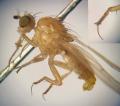Diptera.info :: Identification queries :: Other insects, spiders, etc.
|
Bees ID and behavior interpretation
|
|
| Rui Andrade |
Posted on 14-05-2008 00:05
|
|
Member Location: Portugal Posts: 3123 Joined: 19.06.07 |
Can anyone explain me what this red-abdomen bee was doing? I saw it digging through the hole and next to it there were two dying bees of a different species. Why was it forcing the entrance of the nest while killing the nest's owners? I also noticed small parasites on the invading bee, what are they? location: Barcelos, Portugal date: 11/05/2008     |
| Christian Schmid-Egger |
Posted on 14-05-2008 06:44
|
|
Member Location: Germany, Berlin Posts: 233 Joined: 05.08.05 |
The red bee is a Sphecodes spec, a parasit of Lasioglossum species (dying be). Sphecodes opens nests of his hosts violently and fights with the nest owners. Afterwards, the lay an eg into the nest, and the Sphecodes larva feeds the pollen etc. of the Lasioglossum larva. So, proabably it kills the nest owners. The Lasioglossum may be malachurum or any other social species, with special bees defending the nest entrance (probably you can see the head of such an defender in the whole). The small light red insect is a "triangulus", a larve of a Melioidae (Coleoptera). They life as parasits on bees, the small larva uses adults bees as vehikel to be carryied into the bee nest. So, you can see two levels of parsitism on your photos. Regards, Christian |
| ChrisR |
Posted on 14-05-2008 10:34
|
|
Super Administrator Location: Reading, England Posts: 7706 Joined: 12.07.04 |
Amazing photos - well done!  |
| cthirion |
Posted on 15-05-2008 10:40
|
|
Member Location: Awirs (Flémalle) Belgique Posts: 901 Joined: 13.08.04 |
triongulin=larva of the Meloidae! Not found "triangulus"! 
cthirion |
| ChrisR |
Posted on 15-05-2008 12:26
|
|
Super Administrator Location: Reading, England Posts: 7706 Joined: 12.07.04 |
Or triungulin  |
| cthirion |
Posted on 15-05-2008 15:27
|
|
Member Location: Awirs (Flémalle) Belgique Posts: 901 Joined: 13.08.04 |
Yes 
cthirion |
| Rui Andrade |
Posted on 15-05-2008 23:24
|
|
Member Location: Portugal Posts: 3123 Joined: 19.06.07 |
Thank you very much all of you for your help . . |
| Jump to Forum: |













